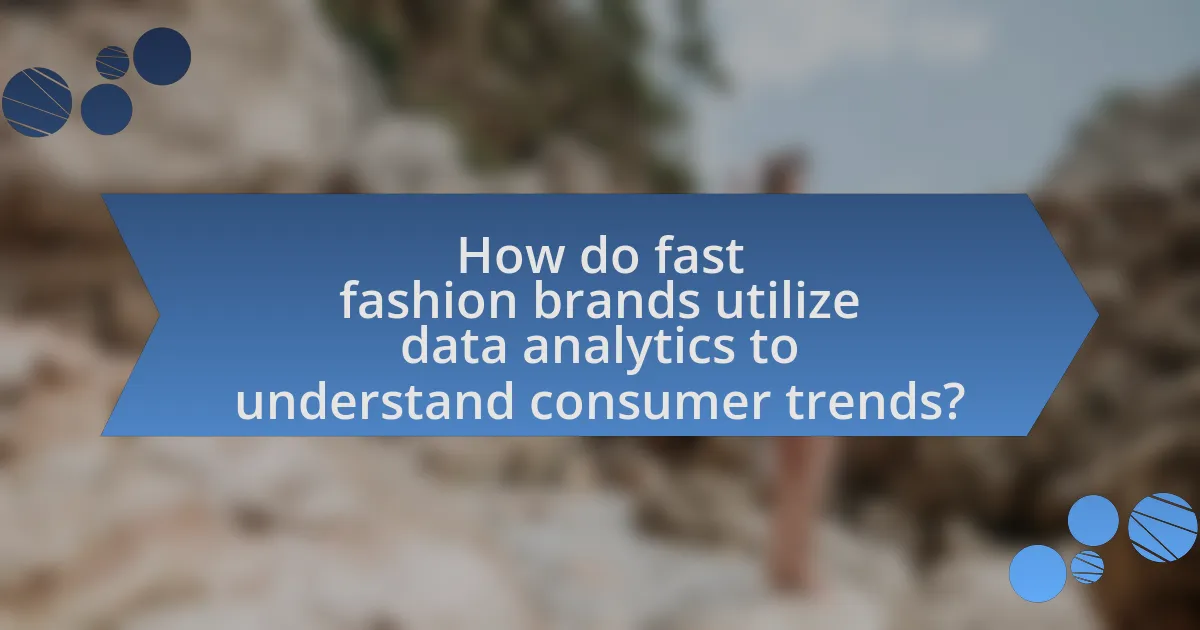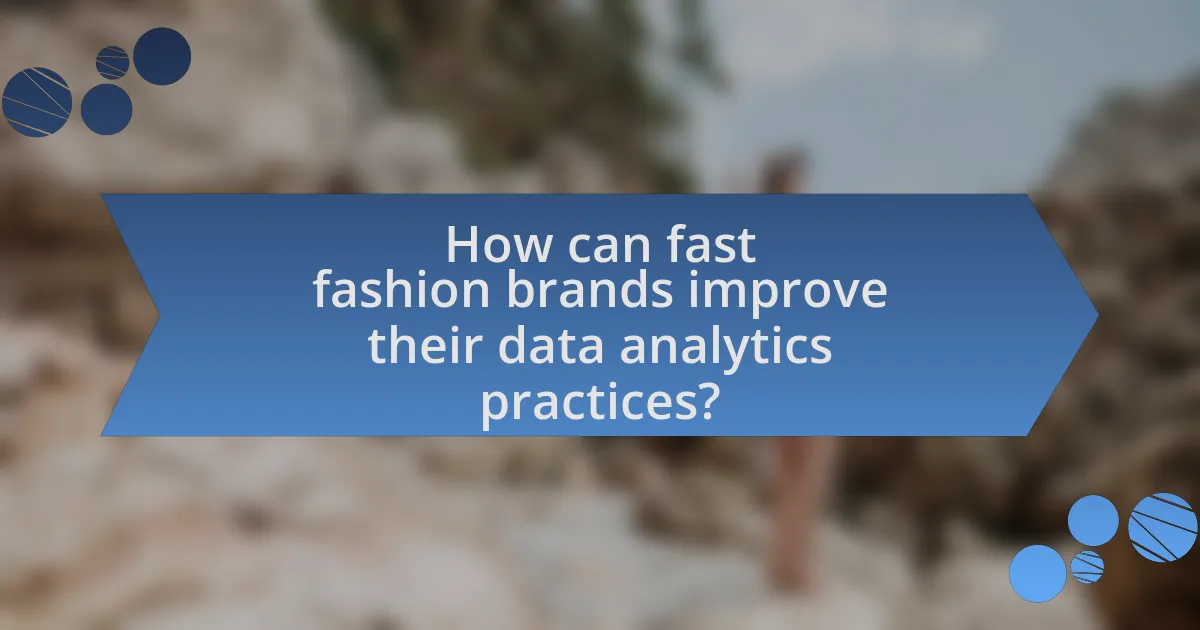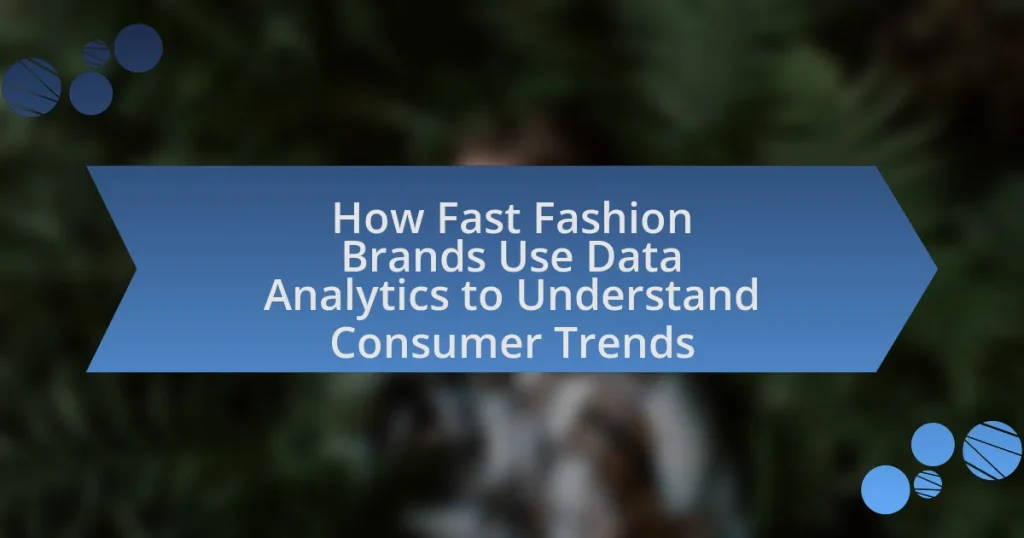Fast fashion brands leverage data analytics to gain insights into consumer trends by analyzing purchasing behavior, social media interactions, and market demand patterns. They collect various data types, including consumer behavior, sales, inventory, and social media engagement data, to optimize inventory management and product development. The article explores how brands gather and analyze consumer data, the role of social media insights, and the impact of data analytics on marketing strategies and inventory management. It also addresses challenges faced in data analytics, such as privacy concerns and data quality issues, while highlighting best practices for improving data analytics practices in the fast fashion industry.

How do fast fashion brands utilize data analytics to understand consumer trends?
Fast fashion brands utilize data analytics to understand consumer trends by analyzing purchasing behavior, social media interactions, and market demand patterns. These brands collect vast amounts of data from various sources, including online sales, customer feedback, and trend forecasting tools. For instance, companies like Zara and H&M employ advanced algorithms to track which items are selling quickly and which styles are gaining traction on social media platforms. This data-driven approach allows them to adjust inventory levels, optimize supply chains, and design new collections that align with current consumer preferences. Research indicates that brands leveraging data analytics can reduce lead times by up to 50%, enabling them to respond swiftly to changing trends and consumer demands.
What types of data do fast fashion brands collect?
Fast fashion brands collect various types of data, including consumer behavior data, sales data, inventory data, and social media engagement data. Consumer behavior data encompasses information on purchasing patterns, preferences, and demographics, which helps brands tailor their offerings. Sales data provides insights into which products are performing well and informs restocking decisions. Inventory data tracks stock levels and turnover rates, enabling efficient supply chain management. Social media engagement data reveals trends and customer sentiments, allowing brands to adapt their marketing strategies accordingly. These data types are essential for fast fashion brands to quickly respond to market demands and optimize their operations.
How do brands gather consumer data from online platforms?
Brands gather consumer data from online platforms primarily through tracking user interactions, utilizing cookies, and analyzing social media engagement. By implementing tracking technologies, brands can monitor website visits, page views, and user behavior, which provides insights into consumer preferences and trends. For instance, a report by Statista indicates that 79% of marketers use web analytics tools to understand user behavior, demonstrating the prevalence of this method. Additionally, brands leverage social media platforms to collect data on consumer sentiments and engagement metrics, allowing them to tailor marketing strategies effectively. This multifaceted approach enables brands to create personalized experiences and optimize their offerings based on real-time consumer insights.
What role do social media insights play in data collection?
Social media insights play a crucial role in data collection by providing real-time feedback on consumer preferences and behaviors. These insights allow fast fashion brands to analyze trends, gauge customer sentiment, and identify emerging styles based on user interactions and engagement metrics. For instance, a study by Sprout Social found that 70% of consumers feel more connected to brands that engage with them on social media, highlighting the importance of these platforms in understanding consumer trends. By leveraging social media analytics, brands can tailor their marketing strategies and product offerings to align with consumer demands, ultimately enhancing their competitive edge in the fast fashion industry.
How do fast fashion brands analyze consumer behavior?
Fast fashion brands analyze consumer behavior primarily through data analytics, utilizing various methods such as tracking online shopping patterns, social media interactions, and customer feedback. By employing advanced algorithms and machine learning techniques, these brands can identify trends, preferences, and purchasing habits in real-time. For instance, a study by McKinsey & Company highlights that 70% of fast fashion companies leverage data analytics to optimize inventory and enhance customer experience. This data-driven approach allows brands to respond quickly to changing consumer demands, ensuring they remain competitive in the fast-paced fashion industry.
What analytical tools are commonly used in the fast fashion industry?
Common analytical tools used in the fast fashion industry include data analytics software, customer relationship management (CRM) systems, and inventory management systems. Data analytics software, such as Google Analytics and Tableau, enables brands to analyze consumer behavior and sales trends effectively. CRM systems, like Salesforce, help fast fashion companies manage customer interactions and gather insights on preferences and purchasing patterns. Inventory management systems, such as SAP and Oracle, assist in tracking stock levels and optimizing supply chain operations. These tools collectively enhance decision-making and responsiveness to market demands, which is crucial in the fast-paced environment of fast fashion.
How do brands segment their consumer data for better insights?
Brands segment their consumer data by utilizing demographic, psychographic, behavioral, and geographic criteria to gain better insights. This segmentation allows brands to tailor their marketing strategies and product offerings to specific consumer groups, enhancing engagement and sales. For instance, a study by McKinsey & Company found that companies that effectively use data segmentation can increase their marketing ROI by up to 15-20%. By analyzing factors such as age, income, lifestyle preferences, and purchasing behavior, brands can create targeted campaigns that resonate with distinct segments of their audience, ultimately driving more effective consumer interactions.
What impact does data analytics have on product development?
Data analytics significantly enhances product development by enabling brands to make data-driven decisions that align with consumer preferences. Fast fashion brands utilize analytics to track trends, analyze customer feedback, and optimize inventory management, resulting in products that better meet market demands. For instance, a study by McKinsey & Company found that companies leveraging data analytics in product development can reduce time-to-market by up to 20%. This efficiency not only accelerates the design process but also increases the likelihood of product success in a competitive landscape.
How do consumer trends influence design decisions?
Consumer trends significantly influence design decisions by guiding brands to align their products with current market demands and preferences. Fast fashion brands utilize data analytics to track consumer behavior, preferences, and emerging trends, allowing them to make informed design choices that resonate with their target audience. For instance, a report by McKinsey & Company highlights that 66% of consumers are willing to pay more for sustainable products, prompting brands to incorporate eco-friendly materials and practices into their designs. This data-driven approach ensures that design decisions are not only aesthetically appealing but also relevant and appealing to consumers, ultimately driving sales and brand loyalty.
What is the relationship between data analytics and inventory management?
Data analytics plays a crucial role in inventory management by enabling brands to optimize stock levels based on consumer demand patterns. Fast fashion brands utilize data analytics to analyze sales trends, forecast demand, and manage inventory turnover effectively. For instance, a study by McKinsey & Company highlights that companies leveraging data analytics can reduce excess inventory by up to 30%, thereby improving profitability and reducing waste. This relationship underscores the importance of data-driven decision-making in maintaining efficient inventory systems that align with consumer preferences.

Why is understanding consumer trends crucial for fast fashion brands?
Understanding consumer trends is crucial for fast fashion brands because it enables them to quickly adapt their offerings to meet changing consumer preferences and demands. Fast fashion operates on a model that relies on rapid production cycles and timely inventory turnover; therefore, brands that effectively analyze and interpret consumer trends can optimize their designs, marketing strategies, and supply chain processes. For instance, a report by McKinsey & Company highlights that brands leveraging data analytics to track consumer behavior can increase their sales by up to 20% by aligning their products with current market demands. This responsiveness not only enhances customer satisfaction but also drives competitive advantage in a highly dynamic industry.
How does consumer trend analysis affect marketing strategies?
Consumer trend analysis significantly influences marketing strategies by enabling brands to tailor their offerings to meet evolving customer preferences. By analyzing data on consumer behavior, fast fashion brands can identify trends in styles, colors, and purchasing patterns, allowing them to adjust their product lines and marketing campaigns accordingly. For instance, a report by McKinsey & Company highlights that brands leveraging data analytics can reduce lead times and increase sales by aligning their inventory with current consumer demands. This strategic alignment not only enhances customer satisfaction but also optimizes resource allocation, ultimately driving profitability.
What are the benefits of targeted marketing based on consumer data?
Targeted marketing based on consumer data significantly enhances marketing effectiveness by allowing brands to tailor their messages and offers to specific consumer segments. This approach increases engagement rates, as personalized content resonates more with consumers, leading to higher conversion rates. For instance, a study by McKinsey & Company found that personalized marketing can lead to a 10-30% increase in sales. Additionally, targeted marketing optimizes advertising spend by focusing resources on high-potential customers, reducing waste associated with broad, untargeted campaigns. This data-driven strategy not only improves customer satisfaction through relevant offerings but also fosters brand loyalty, as consumers feel understood and valued.
How do brands adapt their messaging to align with consumer preferences?
Brands adapt their messaging to align with consumer preferences by utilizing data analytics to gain insights into consumer behavior and trends. Fast fashion brands, for example, analyze purchasing patterns, social media interactions, and customer feedback to tailor their marketing strategies. This data-driven approach allows brands to create targeted campaigns that resonate with specific demographics, ensuring that their messaging reflects current consumer interests and values. Research indicates that 70% of consumers prefer personalized experiences, which reinforces the importance of aligning brand messaging with consumer preferences to enhance engagement and loyalty.
What challenges do fast fashion brands face in data analytics?
Fast fashion brands face significant challenges in data analytics, primarily due to the rapid pace of trend changes and the vast amount of data generated from various sources. The fast fashion industry is characterized by short product life cycles, which complicates the ability to analyze consumer preferences effectively. Additionally, integrating data from multiple channels, such as online sales, social media, and in-store purchases, poses a logistical challenge. According to a report by McKinsey & Company, 75% of fashion executives believe that data analytics is crucial for understanding consumer behavior, yet many struggle with data quality and consistency. This inconsistency can lead to inaccurate insights, hindering decision-making processes. Furthermore, the lack of skilled personnel who can interpret complex data sets exacerbates these challenges, limiting the ability of fast fashion brands to leverage analytics for competitive advantage.
How do privacy concerns impact data collection efforts?
Privacy concerns significantly hinder data collection efforts by limiting the types of data that can be gathered and the methods used to collect it. Regulations such as the General Data Protection Regulation (GDPR) impose strict guidelines on how personal data can be collected, stored, and processed, which directly affects fast fashion brands’ ability to analyze consumer behavior. For instance, a survey by the International Association of Privacy Professionals found that 70% of companies reported that privacy regulations have made data collection more challenging. Consequently, brands must invest in compliance measures and adopt transparent data practices, which can slow down their ability to quickly adapt to consumer trends.
What limitations exist in the data analytics process for fast fashion?
The limitations in the data analytics process for fast fashion include data quality issues, rapid trend changes, and ethical concerns. Data quality issues arise from incomplete or inaccurate data, which can lead to misguided insights; for instance, if consumer feedback is not properly collected, it may misrepresent preferences. Rapid trend changes in the fast fashion industry make it challenging to analyze data effectively, as trends can shift within weeks, rendering previous data obsolete. Ethical concerns also limit data analytics, particularly regarding consumer privacy and the sustainability of data collection practices, which can lead to backlash against brands that fail to address these issues.

How can fast fashion brands improve their data analytics practices?
Fast fashion brands can improve their data analytics practices by integrating advanced machine learning algorithms to analyze consumer behavior and trends in real-time. By leveraging these algorithms, brands can process large datasets from various sources, such as social media, sales data, and customer feedback, allowing for more accurate predictions of fashion trends and consumer preferences. For instance, a study by McKinsey & Company highlighted that companies using data analytics effectively can increase their profitability by up to 20%. This demonstrates that implementing sophisticated data analytics tools not only enhances decision-making but also drives financial performance in the fast fashion sector.
What best practices should brands follow for effective data analysis?
Brands should follow best practices such as defining clear objectives, ensuring data quality, utilizing advanced analytics tools, and fostering a data-driven culture for effective data analysis. Clear objectives guide the analysis process, helping brands focus on relevant metrics that align with their goals. Ensuring data quality involves validating and cleaning data to eliminate inaccuracies, which is crucial for reliable insights. Utilizing advanced analytics tools, such as machine learning algorithms, enables brands to uncover patterns and trends in consumer behavior efficiently. Finally, fostering a data-driven culture encourages all employees to leverage data in decision-making, enhancing overall organizational effectiveness. These practices are supported by industry studies indicating that companies with a strong data culture are five times more likely to make faster decisions than their competitors.
How can brands ensure data accuracy and reliability?
Brands can ensure data accuracy and reliability by implementing robust data governance frameworks and utilizing advanced data validation techniques. A strong data governance framework establishes clear policies and procedures for data management, ensuring that data is collected, stored, and processed consistently. Advanced data validation techniques, such as automated checks and cross-referencing data from multiple sources, help identify and correct errors in real-time. According to a study by Gartner, organizations with effective data governance can improve data quality by up to 40%, which directly enhances decision-making processes and consumer insights in fast fashion analytics.
What role does continuous learning play in data analytics improvement?
Continuous learning is essential for improving data analytics as it enables analysts to adapt to evolving data landscapes and methodologies. By consistently updating their skills and knowledge, data professionals can leverage new tools, techniques, and algorithms that enhance data interpretation and decision-making processes. For instance, a study by McKinsey & Company found that organizations that prioritize continuous learning in analytics see a 20% increase in productivity and a 15% improvement in decision-making accuracy. This ongoing education allows fast fashion brands to better understand consumer trends, optimize inventory management, and tailor marketing strategies effectively.
What future trends in data analytics should fast fashion brands consider?
Fast fashion brands should consider the integration of artificial intelligence and machine learning in data analytics to enhance predictive capabilities and consumer insights. These technologies enable brands to analyze vast amounts of data quickly, identifying trends and consumer preferences in real-time. For instance, a McKinsey report highlights that companies using AI in their supply chain can reduce forecasting errors by up to 50%, leading to more efficient inventory management and reduced waste. Additionally, the use of advanced analytics for personalization will allow brands to tailor marketing strategies and product offerings to individual consumer behaviors, increasing engagement and sales.
How might advancements in AI and machine learning impact data analytics?
Advancements in AI and machine learning significantly enhance data analytics by enabling faster processing of large datasets and improving predictive accuracy. These technologies allow for the automation of data collection and analysis, which increases efficiency and reduces human error. For instance, machine learning algorithms can identify patterns and trends in consumer behavior that traditional analytics methods might overlook, leading to more informed decision-making in fast fashion brands. According to a report by McKinsey & Company, companies that leverage AI in their analytics can achieve up to a 20% increase in productivity and a 30% reduction in costs, demonstrating the tangible benefits of these advancements in the field.
What emerging technologies could enhance consumer trend analysis?
Emerging technologies that could enhance consumer trend analysis include artificial intelligence (AI), machine learning (ML), and big data analytics. AI and ML enable brands to process vast amounts of consumer data quickly, identifying patterns and predicting future trends with high accuracy. For instance, a study by McKinsey & Company found that companies using AI for consumer insights can improve their marketing effectiveness by up to 30%. Additionally, big data analytics allows for real-time analysis of consumer behavior across multiple platforms, providing fast fashion brands with actionable insights to adapt their strategies promptly. These technologies collectively empower brands to stay ahead of market trends and consumer preferences effectively.
What practical steps can fast fashion brands take to leverage data analytics effectively?
Fast fashion brands can leverage data analytics effectively by implementing real-time inventory tracking systems. These systems allow brands to monitor stock levels and consumer purchasing patterns, enabling them to adjust production and supply chain operations promptly. For instance, Zara utilizes data analytics to analyze sales data and customer feedback, which informs their design and inventory decisions, resulting in a 15% increase in sales efficiency. Additionally, brands can employ predictive analytics to forecast trends based on historical data, helping them to align their collections with consumer preferences. By analyzing social media trends and customer reviews, brands can gain insights into emerging styles, allowing them to respond quickly to market demands.















